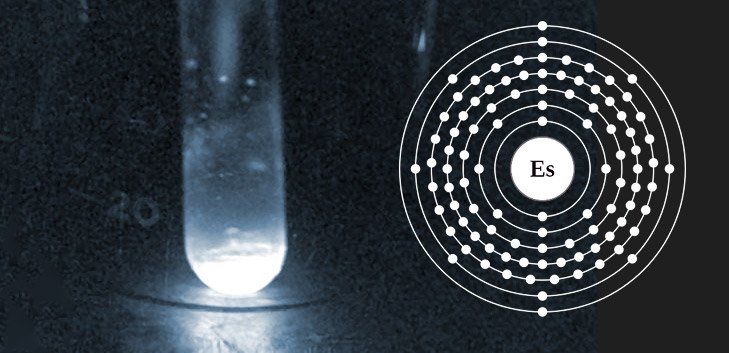where the Einsteinium first detected
The element number 99 Einsteinium is not so big a mystery anymore
The element 99, Einsteinium (Es) is the element, that is named after Albert Einstein. The chemical of that element has been a mystery, and only one thing is sure, Einsteinium could be suitable fuel for small and powerful nuclear reactors. If the production of that element would be cheaper.
But the use of the Einsteinium in the futuristic nuclear reactors and as the "spice" in the new type of "MOX" (Mixed oxide fuel)fuel of the nuclear reactors. The Einsteinium can also use as the "spice" for the be used in the fission stage of the most modern nuclear weapons. The nuclear test ban treaty continues, but also the development of nuclear weapons continues in the countries, that are outside that treaty.
But as you know other things in that element are been outside the chemical research, because Einsteinium is highly radioactive. The form of Einsteinium is solid, dark silver what sends blue light in dark. That tells that the Einsteinium can cause radioactive poisoning to people who are around that element.
Image II: Einsteinium and its blue shine
Production of Einsteinium happens by bombing Curium with neutrons, and that means the production is extremely expensive. For the chemical tests the researchers of Oak Ridges national laboratory, Tennessee formed 215 micrograms of Einsteinium for the X-ray crystallography, and in that kind of tests, the special holder for that kind of sample must be made by using the 3D printer.
Also along with curving the X-rays during those tests there were made the x-ray spectroscopy tests. Those tests measured the X-ray absorption and emission of the material, and that thing is called an X-ray spectrometer. When X-rays are impacting the material they would adjust the atoms to a higher energy level. And when the energy level of those atoms return to the normal level, that thing causes that the atoms are sending photons.
Or in the cases of radioactive nuclear material, the emission will send Alpha, Beta, and Gamma radiation. The Alpha particle is the nucleus of helium. Beta is a fast electron, and gamma radiation is electromagnetic wave movement. The radioactive material sends alpha-particles when they are turning to another element.
The gamma radiation is sending when the radioactive atom releases its over-energetic position. When electromagnetic radiation hits an atom it will pump energy into it. This is the idea of laser and other active spectroscopes like X- or Gamma-ray spectroscopes. Those systems pump energy to atoms And then the atoms will release that energy as the EM-radiation, which can be detected by the spectroscope. The high-price along with problems to handle Einsteinium the research with that material is difficult.
https://consent.yahoo.com/v2/collectConsent?sessionId=3_cc-session_1104bc34-677b-46d6-81e6-aa4a630e4734
https://www.news18.com/news/buzz/einsteinium-element-named-after-albert-einstein-no-more-a-mystery-as-scientists-discover-its-properties-3410576.html
https://www.nytimes.com/2021/02/07/science/einsteinium-chemistry-elements.html
https://www.radiationanswers.org/radiation-introduction/types-of-radiation/types-of-emissions.html
https://en.wikipedia.org/wiki/Absorption_%28electromagnetic_radiation%29
https://en.wikipedia.org/wiki/Einsteinium
https://en.wikipedia.org/wiki/MOX_fuel
Image I:https://images-of-elements.com/s/einsteinium.jpg
Image II: https://www.scinexx.de/wp-content/uploads/e/i/einsteiniumg.jpg





No comments:
Post a Comment
Note: Only a member of this blog may post a comment.